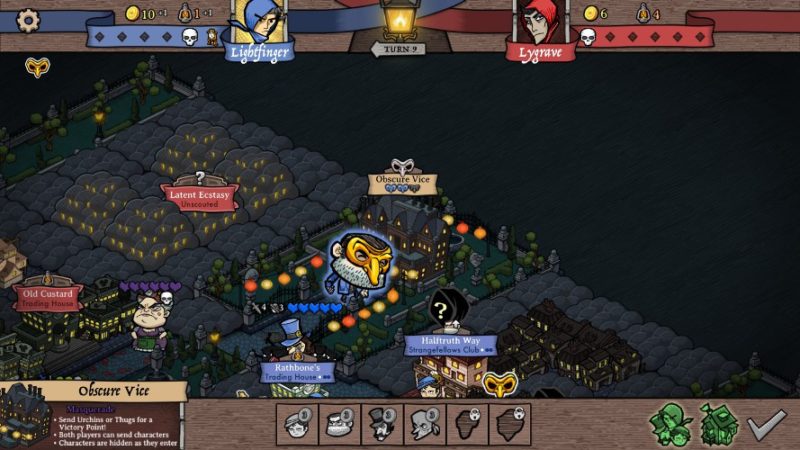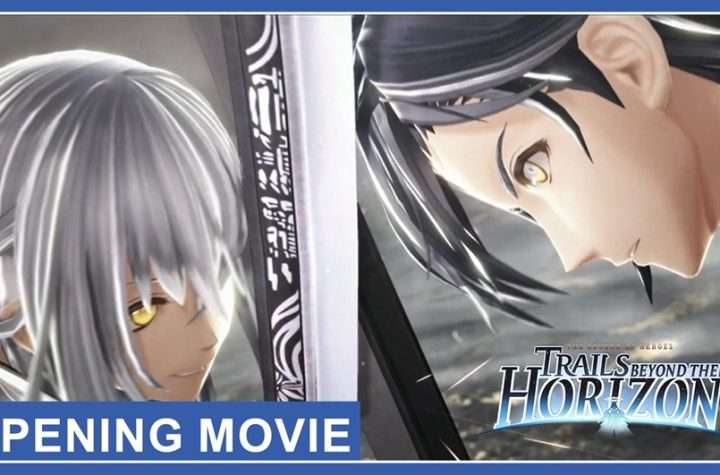Antihero by Independent video game publisher Versus Evil, in partnership with independent developer Tim Conkling, is a turn-based strategy game. Well, it would probably be more accurate to call it a thief-based chess game. The reason I think this is because the game has a tile-based movement system, every match is between two players (or one player and one computer-controlled opponent) who take turns acting, and every unit and system has at least one countermeasure/unit that works against it. Unlike chess, there is no piece that is clearly designated as the king or the queen.
Every match has the goal of being the first player to acquire a number of ‘victory points.’ These victory points can be acquired by doing things such as assassinating a corrupt official; finding blackmail within a church; or buying off an official. Other maps sometimes have additional ways of getting victory points. Some maps actually require the collection of these map-specific objectives. For example, on the palace map (both the campaign and multiplayer version) the player needs to infiltrate the palace as well as acquire the required number of victory points to win.
On a player’s turn, they can have their ‘master thief’ perform a number of actions (the base number is 2 actions, but this can be upgraded), have other available units perform one action, spend coins on new units (assuming the player has enough), and access the upgrade menu. Moving a unit to a space that your master thief has uncovered does not count as an action. If the player clicks on the end turn button and you have units that still have action points or you haven’t visited the upgrade menu during that turn, the game will warn you about this and ask if you still want to end your turn. Once the player’s turn ends, all units on the map except for gangs and thugs will leave the map to hide out in the thief headquarters and the other player starts their turn as their units leave the enemy thief headquarters.
There are 6 different units in the game alongside your master thief. They are the urchins, gangs, thugs, assassins, truant officers, and saboteurs. The ‘master thief’ is your main unit—and the only unit able to perform more than one action. The master thief is also the only unit you have that, as of right now, can’t be killed. The master thief can use his/her action points to uncover up to 3 hidden tiles (these tiles need to be connected) or burgle/scout a building (or attack a killable unit once per turn, provided you got the dagger upgrade). If the building is hidden, then the building—and all buildings in the same district—are revealed to the player and the thief will enter the building on the tile you selected. If you know what the building is, then the thief will enter it. If the building is a regular house or a mansion, then the thief will burgle the building—assuming the building has anything that can be taken. If the building is a bank, trading house, church, bar, or orphanage, then the building will be scouted out and open for infiltration.
The ‘urchin’ is able to infiltrate buildings that have been opened up for infiltration—provided the building doesn’t have urchins from the other player and there are less than 3 of your urchins in the building. Each building has a benefit for 1 urchin infiltrating it and an additional benefit for 3 urchins infiltrating it. For example, the bank will give the player 1 gold per turn for one urchin and an additional 2 gold—adding up to a total of 3 gold—for 3 urchins in the bank. Urchins can only be removed by units capable of evicting them.
The ‘gang’ can attack any unit on a tile that is visible to you or can evict 1 to 3 urchins from a building. Each time the gang kills a unit or evicts an urchin, they gain access to a level-up point which can improve the amount of damage they can do, the number of urchins they can evict, or the amount of gold they earn for the player with each successful kill/eviction. The base stats for the gang is 1 damage, 1 urchin eviction, and 1 gold per kill. Gangs can also act as a roadblock. Gangs are able to be moved to any uncovered space as long as they haven’t used their action point. The downside is that you can only have 1 gang at a time (or 2 if you get the upgrade for 2) and they can be damaged/killed themselves—something which can be annoying if you spent a while getting the gang to a high level.
The ‘thug’ has a base of 1 hit-point and works as a roadblock for 2 turns (after which, assuming they’re still alive, they will leave). The thug can also be added to one of your gangs to give the gang an additional hit-point (up to 6 without buffs). When you tell your thug to guard a space or join a gang, you will then lose the thug as they do what you have ordered of them. Additionally, some units are able to ignore roadblocks (or the enemy player can find an alternative route).
The ‘assassin’ is able to do 6 damage to killable units. While this might sound pathetic, keep in mind that it is rare to come across a unit that has more than 6 health. After attacking their target, the assassin will then leave. The assassin is one of the more expensive units, so I would recommend using it sparingly.
The ‘truant officer’ is able to evict all urchins from a building, making this unit a scary one. Like the assassin, it is expensive and will leave after successfully completing its task. However, if the building has a trap set in it, then the officer will instead be stunned and will remain on the map during the other player’s turn with one hit-point.
The ‘saboteur’ is able to set a trap in an uncovered infiltrated building or uncover all the buildings in a district—provided the district is connected to a visible tile. The trap will stun any master thief, gang, or truant officer that tries to enter the building. If the trap stuns the enemy master thief, they will lose their remaining action points. The trap itself will only last for 2 turns.
The upgrade menu will allow you to buy upgrades (provided you have enough lanterns, the currency for upgrades) or accept charity in the form of 4 coins or 2 lanterns. Accepting charity will inhibit you from buying an upgrade that turn (and buying an upgrade will inhibit you from accepting charity). I found this charity system to be a nice addition, as it ensured that cornered players still had some means of recovering.
Overall, the presence of at least one countermeasure for every unit and the ability to accept charity once per turn at the cost of an upgrade create the feeling of a high-level chess game. One wrong move can create a huge setback if the opponent is skilled enough to exploit it. As such, I think a fair rating for Antihero would be 9/10.
Here is the Antihero Launch Trailer:
Antihero is now available for PC and Mac. You can find it on Steam and the official website.
PC Review
-
Overall Score - 9/109/10
I am a recent Computer Science/Game Development Programming Chapman University Graduate. I am a life long enthusiast of computer/video gaming and my favorite game genres are adventure, choice-driven stories, fighting, and racing. My favorite game/movie series include but aren't limited to 'Legend of Zelda'; 'Dragon Age'; 'Persona'; 'Sonic the Hedgehog'; 'Mario'; 'Metroid' ;'Megaman'; 'Naruto'; 'Batman'; 'Spiderman'; 'Star Wars'; and 'Star Trek.'














More Stories
I AM FUTURE Review for PlayStation 5
PUBG: BLINDSPOT will be Launching on February 5th via Early Access
GTA Online: Money Fronts, HSW Race Bonuses, Free Hands-on Car Wash Property, Plus Much More